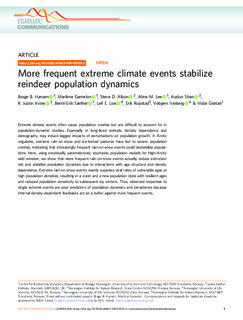| dc.contributor.author | Hansen, Brage Bremset | |
| dc.contributor.author | Gamelon, Marlène | |
| dc.contributor.author | Albon, Steve D. | |
| dc.contributor.author | Lee, Aline Magdalena | |
| dc.contributor.author | Stien, Audun | |
| dc.contributor.author | Irvine, Robert Justin | |
| dc.contributor.author | Sæther, Bernt-Erik | |
| dc.contributor.author | Loe, Leif Egil | |
| dc.contributor.author | Ropstad, Erik | |
| dc.contributor.author | Veiberg, Vebjørn | |
| dc.contributor.author | Grøtan, Vidar | |
| dc.date.accessioned | 2019-05-20T07:03:15Z | |
| dc.date.available | 2019-05-20T07:03:15Z | |
| dc.date.created | 2019-03-06T06:58:01Z | |
| dc.date.issued | 2019 | |
| dc.identifier.issn | 2041-1723 | |
| dc.identifier.uri | http://hdl.handle.net/11250/2597931 | |
| dc.description.abstract | Extreme climate events often cause population crashes but are difficult to account for in population-dynamic studies. Especially in long-lived animals, density dependence and demography may induce lagged impacts of perturbations on population growth. In Arctic ungulates, extreme rain-on-snow and ice-locked pastures have led to severe population crashes, indicating that increasingly frequent rain-on-snow events could destabilize populations. Here, using empirically parameterized, stochastic population models for High-Arctic wild reindeer, we show that more frequent rain-on-snow events actually reduce extinction risk and stabilize population dynamics due to interactions with age structure and density dependence. Extreme rain-on-snow events mainly suppress vital rates of vulnerable ages at high population densities, resulting in a crash and a new population state with resilient ages and reduced population sensitivity to subsequent icy winters. Thus, observed responses to single extreme events are poor predictors of population dynamics and persistence because internal density-dependent feedbacks act as a buffer against more frequent events. | nb_NO |
| dc.language.iso | eng | nb_NO |
| dc.publisher | Nature Publishing Group | nb_NO |
| dc.relation.uri | https://www.nature.com/articles/s41467-019-09332-5 | |
| dc.rights | Navngivelse 4.0 Internasjonal | * |
| dc.rights.uri | http://creativecommons.org/licenses/by/4.0/deed.no | * |
| dc.title | More frequent extreme climate events stabilize reindeer population dynamics | nb_NO |
| dc.type | Journal article | nb_NO |
| dc.type | Peer reviewed | nb_NO |
| dc.description.version | publishedVersion | nb_NO |
| dc.source.volume | 10 | nb_NO |
| dc.source.journal | Nature Communications | nb_NO |
| dc.identifier.doi | 10.1038/s41467-019-09332-5 | |
| dc.identifier.cristin | 1682518 | |
| dc.relation.project | Norges forskningsråd: 244647 | nb_NO |
| dc.relation.project | Norges forskningsråd: 216051 | nb_NO |
| dc.relation.project | Norges forskningsråd: 276080 | nb_NO |
| dc.relation.project | Norges forskningsråd: 223257 | nb_NO |
| dc.description.localcode | Open Access This article is licensed under a Creative Commons Attribution 4.0 International License, which permits use, sharing, adaptation, distribution and reproduction in any medium or format, as long as you give appropriate credit to the original author(s) and the source, provide a link to the Creative Commons license, and indicate if changes were made. | nb_NO |
| cristin.unitcode | 194,66,10,0 | |
| cristin.unitname | Institutt for biologi | |
| cristin.ispublished | true | |
| cristin.fulltext | original | |
| cristin.qualitycode | 2 | |

